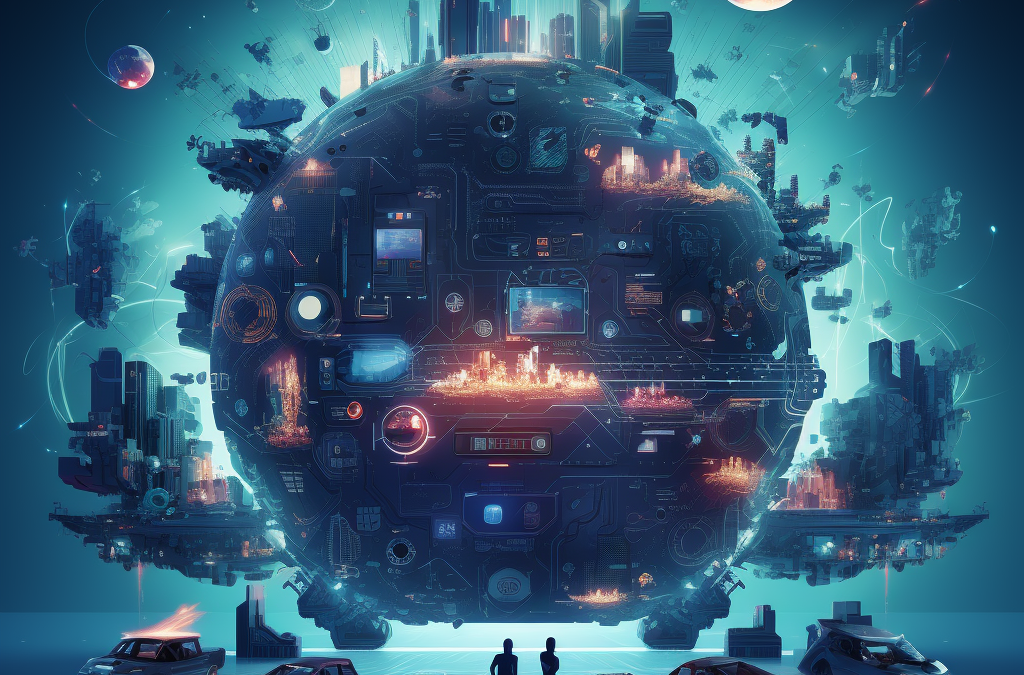Are you ready to level up your understanding of gamification mechanics? Imagine being able to create immersive and compelling game experiences that keep users hooked from start to finish. It’s time to demystify the world of gamification and uncover the secrets behind its power.
In today’s fast-paced world, where user engagement is paramount, gamification has emerged as a game-changer. By incorporating game mechanics into various applications and platforms, you can captivate your audience, drive user engagement, and achieve desired behaviors.
But what exactly are gamification mechanics, and how can they be leveraged to create unforgettable experiences? In this blog, we’ll explore the core principles and components of gamification design. Prepare to dive deep into the world of user experience, game dynamics, and player motivation.
Introduction to Gamification
Gamification, a concept gaining increasing relevance across various domains, involves the integration of game elements and mechanics into non-gaming contexts to enhance user engagement and motivation. By tapping into the inherent human desire for competition, achievement, and fun, gamification can transform mundane tasks into immersive and rewarding experiences.
Incorporating game elements such as points, badges, leaderboards, and challenges into applications, websites, and other platforms can incentivize users, driving desired behaviors and fostering a sense of accomplishment. Whether it’s a mobile app, a language-learning platform, or a fitness tracker, gamification has the potential to captivate users and encourage them to reach new levels of engagement.
The benefits of implementing gamification extend beyond mere entertainment. By infusing tasks with game mechanics, businesses can boost user participation and loyalty, increase productivity, and even drive social interactions. For example, fitness apps like Fitbit utilize gamified systems to motivate users to complete tasks, track progress, and compete with friends, ultimately promoting healthier habits.
Gamification harnesses users’ intrinsic motivation by tapping into their core drives, such as a sense of achievement, social influence, and personal development. By capitalizing on these psychological factors, gamified platforms can create a sense of ownership, belonging, and excitement, increasing user satisfaction and long-term engagement.
In the following sections, we will explore the mechanics and principles behind effective gamification design, providing real-world examples and insights on how to leverage game elements to create compelling and immersive user experiences across different domains. Let’s delve deeper into the core components of gamification and unlock the secrets to designing captivating game-based interactions.
Understanding Gamification Mechanics
Gamification mechanics play a crucial role in shaping user behavior and driving engagement within various domains. By integrating game elements into non-gaming contexts, these mechanics create immersive experiences that captivate and motivate users. In this section, we will explore the core components of gamification design, shedding light on the fundamental principles behind its success.
Goals: At the heart of any gamified experience lies a defined set of goals. These objectives provide users with a clear sense of purpose and direction, establishing the pathway to success. Whether it’s completing tasks, unlocking achievements, or mastering new levels, well-designed goals drive user motivation and engagement.
Rules: Gamification relies on a set of rules or guidelines that govern the user’s interactions within the system. These rules define the boundaries, challenges, and constraints that users must navigate to achieve their goals. By establishing a framework for engagement, rules create a structured and meaningful experience.
Feedback: Providing timely and meaningful feedback is crucial for sustaining user motivation. Feedback serves as a compass, guiding users towards desired behaviors and actions. Through visual cues, progress indicators, and performance evaluations, effective feedback reinforces positive actions and highlights areas for improvement.
Rewards: In the realm of gamification, rewards serve as powerful incentives that drive user engagement. Whether it’s in the form of points, badges, or virtual currency, rewards recognize and celebrate user achievements, fostering a sense of accomplishment and satisfaction.
Motivation: Understanding the intrinsic and extrinsic motivators that resonate with users is key to designing effective gamification experiences. By tapping into psychological drivers such as autonomy, competence, and relatedness, gamification mechanics can enhance user motivation and create a sense of purpose.
Freedom of Choice: Allowing users the freedom to choose their own path and approach fosters a sense of autonomy and personal agency. By offering multiple options, branching narratives, and alternative paths, gamification mechanics empower users to make meaningful decisions within the experience.
By comprehending and effectively implementing these core components of gamification design, organizations and designers can craft compelling and engaging experiences that captivate users and drive desired behaviors.
Exploring Key Game Mechanics
When it comes to gamification, understanding the key game mechanics is crucial in creating compelling game experiences. These mechanics serve as the building blocks for engaging and motivating users. Let’s dive into a curated list of commonly used game mechanics and learn how they can be applied to enhance user experiences.
Points
Points are a fundamental game mechanic that serves as a measure of progress and achievement. By awarding points for completing specific tasks or reaching milestones, users feel a sense of accomplishment and motivation to continue. Points can be displayed prominently to provide a visual representation of progress and encourage users to strive for higher levels or scores.
Badges
Badges act as virtual rewards for accomplishing specific goals or mastering certain skills. They not only recognize users’ achievements but also serve as a status symbol within a gamified system. Badges provide a sense of accomplishment and can be shared with others, fostering a sense of competition and creating a social aspect to the gamification experience.
Leaderboards
Leaderboards introduce a competitive element by ranking users based on their progress or performance. They tap into the innate human desire for recognition and social comparison. By displaying the top performers, leaderboards create a sense of competition and motivate users to improve their standing and strive for the top spot.
Relationships
Building relationships between users, whether through collaboration or competition, adds depth to the gamification experience. Social interactions can enhance motivation, encourage teamwork, and create a sense of belonging within a community. By facilitating connections and fostering a sense of camaraderie, relationships enhance user engagement and retention.
Challenges
Challenges provide users with specific tasks or missions to complete, adding a sense of purpose and direction to the game experience. They create a clear goal and provide users with a sense of progress as they overcome obstacles and achieve targets. Challenges can be designed to gradually increase in difficulty, keeping users engaged and motivated as they progress through different stages of the game.
Constraints
Constraints add an element of strategy and decision-making to the game experience. By limiting resources or imposing time constraints, users are forced to make choices and prioritize their actions. Constraints add complexity and challenge, making the game experience more engaging and rewarding as users find creative ways to overcome limitations.
Journey
Journey refers to the narrative or storyline that unfolds throughout the game experience. It provides a sense of progression, purpose, and immersion for users. By presenting a well-crafted narrative arc, game designers can captivate users’ attention, evoke emotions, and create a memorable experience.
By incorporating these game mechanics into your gamification strategy, you can create compelling game experiences that captivate and motivate users. Each mechanic serves a unique purpose, empowering users to progress, compete, collaborate, and achieve within the gamified system. Remember, the key to successful gamification lies in applying these mechanics thoughtfully and aligning them with the desired user behaviors and goals.
The Game Plan: Designing Effective Gamification
Designing a successful gamification strategy requires careful consideration of key elements that drive user engagement and create a captivating and rewarding experience. By incorporating game economy, game rules, and an engagement loop, you can enhance user motivation and encourage desired behaviors.
Game Economy:
The game economy refers to the system that governs the distribution and acquisition of rewards within a gamified experience. It involves designing a balance between the availability and scarcity of rewards to maintain user interest and motivation. By providing meaningful incentives, such as points, badges, or virtual currency, you can create a sense of achievement and progression for users as they interact with your gamified platform or application.
Game Rules:
Clear and well-defined game rules are essential for guiding user behavior and establishing a fair playing field. Game rules define the boundaries, constraints, and mechanics within the gamified experience. They provide structure and guidance, ensuring that users understand the objectives, challenges, and rewards associated with the game. By establishing a set of rules that are easy to understand and follow, you can create a sense of clarity and fairness, enhancing the user experience.
Engagement Loop:
An engagement loop is a cyclical process that keeps users engaged and motivated. It consists of a series of actions, feedback, and rewards that encourage users to progress and continue their interaction with the gamified system. This loop ensures a continuous flow of challenges and rewards, stimulating users’ desire for achievement and progression. By carefully designing this loop, you can maintain users’ interest and create a sense of satisfaction and accomplishment.
When crafting a gamification strategy, it is crucial to consider these elements holistically. The game economy, game rules, and engagement loop should work in harmony to provide a captivating and rewarding user experience. By implementing these essential elements effectively, you can maximize the potential impact of gamification in driving desired behaviors and fostering long-term user engagement.
Real-World Examples of Gamification

Gamification has made a profound impact in various domains by leveraging game mechanics to enhance user engagement and motivation. Let’s dive into some real-world examples that demonstrate the power of gamification and the game mechanics employed to create compelling user experiences.
Fitbit: Turning Fitness into a Game
Fitbit, a popular fitness tracking platform, transforms the pursuit of a healthy lifestyle into an engaging game. By tracking users’ steps, heart rate, and sleep patterns, Fitbit encourages them to surpass their goals and reach new levels of fitness. Fitbit incorporates game mechanics such as points, badges, and leaderboards to motivate users to achieve more and compete with friends or the larger Fitbit community. These game dynamics not only foster a sense of competition but also provide users with a clear sense of progress and achievement.
Waze: Transforming Navigation into an Adventure
Waze, a community-based navigation app, adds a gamified twist to the mundane task of commuting. Users earn points and virtual rewards by reporting accidents, speed traps, and road hazards, encouraging active participation and contribution to the community. Waze’s game mechanics not only make the navigation experience more enjoyable but also create a sense of belonging and shared responsibility among its users. By gamifying the navigation process, Waze has successfully transformed a daily routine into an exciting adventure.
Duolingo: Learning Language through Game Elements
Duolingo, a language-learning platform, uses gamification to make the process of acquiring a new language more engaging and enjoyable. With its game-like elements and progress tracking, Duolingo motivates users to regularly practice and advance their language proficiency. The platform incorporates game mechanics such as points, levels, and achievements, providing users with a sense of accomplishment and progress. By gamifying the language learning experience, Duolingo has attracted millions of users, proving the effectiveness of incorporating game elements into educational contexts.
These examples highlight how gamification has been successfully implemented in diverse industries. By incorporating game mechanics and dynamics, platforms like Fitbit, Waze, and Duolingo have not only increased user engagement but also encouraged long-term commitment and behavior change. These real-world applications demonstrate the potential of gamification to transform routine activities into immersive experiences.
Remember, when designing your own gamified experiences, consider the specific game mechanics and dynamics that will align with your users’ goals and preferences. Use these examples as inspiration to create unique and captivating gamification strategies that resonate with your target audience.
Keep exploring the world of gamification and discover how game elements can be leveraged to create meaningful and rewarding user experiences across various domains.
Unveiling the Core Drives of Gamification
Gamification goes beyond simply applying game mechanics to an experience – it taps into the intrinsic motivation that drives human behavior. To truly leverage the power of gamification, it’s essential to understand the core drives that underpin user engagement. One framework that provides valuable insights into these drivers is Octalysis.
The Octalysis framework, developed by Yu-Kai Chou, identifies eight core drives that can be harnessed to enhance user motivation and engagement. These core drives are essential elements for creating captivating and rewarding gamified experiences.
1. Epic Meaning and Calling: Humans are naturally drawn to activities that provide them a sense of purpose or allow them to contribute to something greater than themselves. By incorporating epic meaning and calling into gamification, you can tap into this core drive and provide users with a sense of purpose and fulfillment.
2. Development and Accomplishment: People have a natural desire to improve themselves, to learn new skills, and to achieve goals. This core drive involves integrating elements such as leveling up, skill progression, and mastery into gamified experiences, allowing users to develop and accomplish tasks.
3. Empowerment of Creativity and Feedback: This core drive encompasses the freedom for users to express their creativity and receive feedback on their contributions. By providing users with tools and platforms to create and express themselves within the gamified system, you can tap into this core drive and inspire greater engagement.
4. Ownership and Possession: Humans have an inherent desire to own or possess things. This core drive involves incorporating elements of ownership, customization, and virtual goods within the gamified experience. By allowing users to accumulate and customize virtual possessions, you can enhance their engagement and motivation.
5. Social Influence and Relatedness: People are inherently social creatures, and this core drive focuses on the importance of social interactions and relationships. By integrating features such as collaboration, competition, and social sharing, you can leverage this core drive to enhance user motivation and foster a sense of community.
6. Scarcity and Impatience: The core drive of scarcity and impatience is centered around the psychological principle that people value things more when they are perceived as scarce. By incorporating time-limited challenges, exclusive rewards, and limited availability, you can tap into this core drive and drive user engagement.
7. Curiosity and Unpredictability: Humans are naturally curious and seek novelty and unpredictability. This core drive involves integrating elements such as surprises, mysteries, and unpredictability into the gamified experience to capture and maintain user attention and engagement.
8. Loss and Avoidance: The core drive of loss and avoidance centers around the human tendency to avoid negative outcomes. By incorporating elements such as penalties, consequences, and loss aversion into gamified experiences, you can leverage this core drive to drive user engagement and motivation.
By understanding and incorporating these core drives into your gamification design, you can create experiences that resonate with users on a deeper level. The Octalysis framework offers a comprehensive guide to leveraging these core drives effectively and crafting engaging and meaningful gamified experiences.
Successful gamification goes beyond superficial game elements – it taps into the fundamental drivers that motivate and engage users.
Conclusion
Gamification mechanics play a crucial role in designing engaging and rewarding user experiences across various domains. By incorporating game elements into different applications and platforms, businesses can enhance user engagement, motivation, and desired behaviors.
Throughout this article, we have explored the key principles and components of gamification design. We have discussed the importance of goals, rules, feedback, rewards, motivation, and freedom of choice in driving user behavior. Additionally, we have delved into various game mechanics like points, badges, leaderboards, relationships, challenges, constraints, and journey, understanding how they can be applied effectively to create compelling game experiences.
Real-world examples, such as Fitbit, Waze, and Duolingo, have showcased the successful application of gamification in motivating users and fostering a sense of achievement. By leveraging game dynamics and understanding the core drives of gamification, businesses can tap into users’ intrinsic motivations and encourage positive engagement.
In the rapidly evolving technology world, gamification has become a powerful tool for enhancing user experiences and driving desired behaviors. By adopting a user-centric attitude and incorporating thoughtful gamification strategies, businesses can create immersive and captivating experiences for their users.
Thoughtful gamification design is essential to ensure a positive impact on user engagement. By considering the principles and mechanics discussed in this article, you can leverage the potential of gamification to foster engagement and drive user behavior in your applications and platforms.
Gamification is not just a trend but a proven approach to creating enjoyable and compelling experiences for users. So, embrace the power of gamification mechanics and witness the transformative impact it can have on your user engagement and overall success.
Join Our Discord HERE for Free Art and NFT Game Items
🌐 https://discord.gg/4KeKwkqeeF
🚤 https://opensea.io/EyeOfUnity
🎭 https://rarible.com/eyeofunity
🍎 https://magiceden.io/u/eyeofunity
Other Websites by System Ent Corp:
https://eyeofunity.com
https://meteyeverse.com
https://000arcade.com
https://00arcade.com
https://0arcade.com
https://wealth-financing.com
https://techgenstore.com
https://systementcorp.com
https://affiliatesbonus.com
https://albertbrain.com
https://lastdaystore.com
https://controlsecret.com
https://realufopics.com
https://officialmikemc.com
https://ashleymega.com

